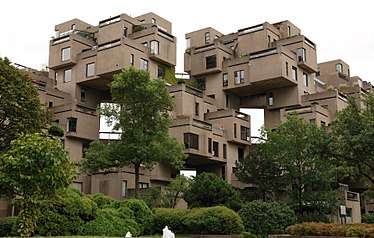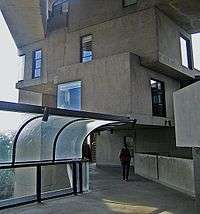Habitat 67
HABITAT 67, or simply Habitat, is a model community and housing complex in Montreal, Quebec, Canada, designed by Israeli-Canadian architect Moshe Safdie. It was originally conceived as his master's thesis in architecture at McGill University and then built as a pavilion for Expo 67, the World's Fair held from April to October 1967. It is located at 2600 Avenue Pierre-Dupuy on the Marc-Drouin Quay next to the Saint Lawrence River. Habitat 67 is widely considered an architectural landmark and one of the most recognizable buildings in both Montreal and Canada.[1][2]

History

Safdie's design for Habitat 67 began as a thesis project for his architecture program at McGill University. It was "highly recognized" at the institution, though Safdie cites its failure to win the Pilkington Prize, an award for the best thesis at Canadian schools of architecture, as early evidence of its controversial nature.[3] After leaving to work with Louis Kahn in Philadelphia, Safdie was approached by Sandy van Ginkel, his former thesis advisor, to develop the master plan for Expo 67, the world's fair that was set to take place in Montreal during 1967. Safdie decided to propose his thesis as one of the pavilions and began developing his plan.[3] After the plans were approved in Ottawa by Mitchell Sharp, the federal cabinet minister responsible for the exhibition, and Prime Minister Lester B. Pearson, Safdie was given the blessing of the Expo 67 Director of Installations, Edward Churchill, to leave the planning committee in order to work on the building project as an independent architect.[3] Safdie was awarded the project in spite of his relative youth and inexperience, an opportunity he later described as "a fairy tale, an amazing fairy tale."[3]
The development was financed by the federal government, but is now owned by its tenants, who formed a limited partnership that purchased the building from the Canada Mortgage and Housing Corporation in 1985. Safdie still owns a penthouse apartment in the building.[4][5]
Safdie's penthouse as well as a tour of a building are available via guided tours.
.jpg)
Concept and design
Habitat 67 comprises 354 identical, prefabricated concrete forms arranged in various combinations, reaching up to 12 stories in height. Together these units create 146 residences of varying sizes and configurations, each formed from one to eight linked concrete units.[6] The complex originally contained 158 apartments,[7] but several apartments have since been joined to create larger units, reducing the total number. Each unit is connected to at least one private terrace, which can range from approximately 20 to 90 square metres (225 to 1,000 sq ft) in size.[6]
The development was designed to integrate the benefits of suburban homes—namely gardens, fresh air, privacy, and multilevelled environments—with the economics and density of a modern urban apartment building.[1] It was believed to illustrate the new lifestyle people would live in increasingly crowded cities around the world.[8] Safdie's goal for the project to be affordable housing largely failed: demand for the building's units has made them more expensive than originally envisioned.[1] In addition, the existing structure was originally meant to only be the first phase of a much larger complex, but the high per-unit cost of approximately C$140,000 (C$22,120,000 for all 158) prevented that possibility.[9]
The structural engineer for the project was August Eduard Komendant, an Estonian-American structural engineer and a pioneer in the field of prestressed concrete.

The theme of Expo 67 was "Man and his World", taken from Antoine de Saint-Exupéry's memoir Terre des hommes (literally "land of men", though it was published under the title Wind, Sand and Stars). Housing was also one of the main themes of Expo 67. Habitat 67 then became a thematic pavilion visited by thousands of visitors who came from around the world, and during the expo also served as the temporary residence of the many dignitaries visiting Montreal.
In March 2012, Habitat 67 won an online Lego Architecture poll and is a candidate to be added to the list of famous buildings that inspire a special replica Lego set. Lego bricks were actually used in the initial planning for Habitat; according to Safdie's firm, "initial models of the project were built using Lego bricks and subsequent iterations were also built with Lego bricks".[10]
Legacy
As one of the major symbols[11] of Expo 67, which was attended by over 50 million people during the 6 months it was open, Habitat 67 gained worldwide acclaim as a "fantastic experiment"[4] and "architectural wonder".[2] This experiment was and is regarded as both a success and failure—it "redefined urban living"[5] and has since become "a very successful co-op",[1] but at the same time ultimately failed to revolutionize affordable housing or launch a wave of prefabricated, modular development as Safdie had envisioned.[1] Despite its problems, however, Habitat's fame and success "made [Safdie's] reputation"[11] and helped launch his career; Safdie has now designed over 75 buildings and master plans around the world.[5]
Even now, decades after Habitat, much of Safdie's work still holds to the concepts that were so fundamental to its design, especially the themes of reimagining high-density housing and improving social integration through architecture that have become "synonymous" with his work.[12]
In 2017, Canada Post issued a commemorative stamp for the 50th anniversary of Expo 67 featuring the structure.[13]
Panorama
References
- Fox, Matthew (January 4, 1997). "At home in Habitat". Toronto Star. p. J1.
- Langan, Fred (March 7, 1997). "The homey feeling of living in boxes". The Christian Science Monitor. Boston. p. 10.
- Wachtel, Eleanor (2008). "Moshe Safdie, Architect (interview)". Queen's Quarterly. 115 (2): 199–219. ISSN 0033-6041.
- Weder, Adele (January–February 2008). "For Everyone a Garden". The Walrus. 5 (1): 88–93. Archived from the original on November 29, 2011. Retrieved November 25, 2011.
- Safdie, Moshe (August 22, 2011). "Moshe Safdie; NFL team Owners Jerry Richardson & Jerry Jones". Charlie Rose (Interview). Interviewed by Charlie Rose. Archived from the original on November 1, 2014. Retrieved November 25, 2011.
- "Habitat 67". Complexe de la cité du havre. Retrieved November 24, 2011.
354 cubes of a magnificent grey-beige build up one on the other to form 146 residences
- Safdie, Moshe (1974). For Everyone a Garden. MIT Press. LCCN 73016432.
- Rémillard, François; Merrett, Brian (1990). Montreal architecture : a guide to styles and buildings. Montreal: Meridian Press. p. 195.
- Penketh, Anne (October 17, 1980). "Habitat, 13 years later". The Globe and Mail.
- "Montreal landmark wins Lego contest". March 7, 2012. Retrieved September 14, 2012. Cite journal requires
|journal=(help) - Safdie, Moshe (June 27, 1997). "Safdie/Stevens/Walker". Charlie Rose (Interview). Interviewed by Charlie Rose. Archived from the original on March 28, 2013. Retrieved November 25, 2011.
- Makary, Martin (February 1, 2007). "A Life Less Ordinary". designbuild-network.com. Retrieved November 25, 2011.
- Mafi, Nick (27 April 2017). "Canada Unveils Stamp of Habitat 67 to Celebrate Its 50th Anniversary". Architectural Digest. Retrieved 30 April 2017.
External links
| Wikimedia Commons has media related to Habitat 67. |
- Official website of Habitat 67
- Official website of Moshe Safdie and Associates
- Habitat 67 at the Moshe Safdie Hypermedia Archive of McGill University
- Habitat 67: Then and Now
- Habitat 67 at Great Buildings Online
- Habitat 67 at ArchiTravel
